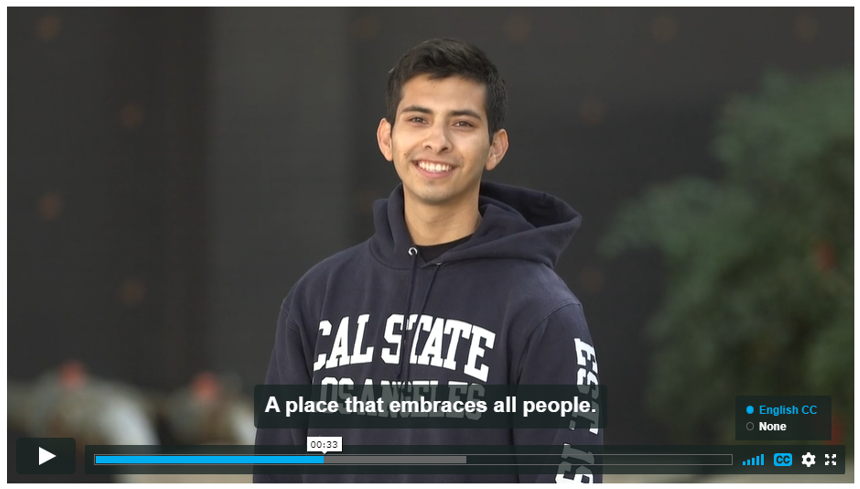Ensure that both human-edited captions are included in videos and audio descriptions are provided in transcripts for audio-only content. This ensures accessibility and enhances the user experience for individuals with different needs. As online experiences increasingly rely on video and audio formats, it's important to cater to diverse audiences by providing comprehensive accessibility features.
To meet University policy requirements, video and audio content must include text-based alternatives so all users can access the information.
Video Captions and Audio Transcripts
Video captions and audio transcripts provide access to people who:
- are deaf or hard of hearing
- are learning another language, or whose native language does not match the audio content (i.e., international students)
- have learning disabilities or other cognitive impairments
- learn by taking in information in multiple ways
- are in quiet environments where audio output is undesirable (i.e., libraries)
- are in noisy environments where audio may be difficult to hear or understand (i.e., student unions).
- do not have equipment that supports audio output (such as headphones)
- are looking for information contained in a video; search engines can find information in captions and transcripts, but not in a video or audio file
Audio Descriptions
Audio descriptions in videos provide access to people who:
- are blind or have low-vision
- are learning another language, or whose native language does not match the audio content (i.e., international students)
- have learning disabilities or other cognitive impairments
- learn by taking in information in multiple ways
- are in visually stimulating environment where looking at the video may be undesirable (i.e., while exercising or driving)
Review, Edit, or Request Captions
Captions are text blocks in a video that display all audio information, including spoken works, sounds, and music. Captions are:
- Time-coded so two (but sometimes three) lines of text appear at a time, usually at the bottom of the video
- Either “closed” (able to be turned on or off by the user) or “open” (on all the time)
- Displayed in the same language as the audio
Subtitles are similar to captions, but they display only spoken content, usually in a language other than the language of the audio, and they can be turned on or off by the user.
Do
Review your videos. Do they include captions that adequately match what the speakers are saying? Are changes in who is speaking labelled, if this is not apparent in the audio? If not, replace the videos or include adequate captions.
| Type of Video | Options |
|---|---|
| Videos You don't own but want Share |
|
| Videos Uploaded to Canvas |
There are no simple workflows to caption videos uploaded directly to Canvas. Consider requesting video to be Caption in Canvas by following the page below: |
Don't
Don't assume that all videos have closed captions.
It's crucial not to rely solely on auto-generated captions, as they may not meet the high accuracy standards required by individuals who are deaf or hard of hearing, which typically exceed 99%. Additionally, auto-generated captions often overlook essential non-speech elements present in the audio.
Don't assume subtitles can take the place of captions
Audio descriptions use the audio track to describe what is happening within a video. With some planning, they are relatively easy to include while recording a new video. They can be added to existing videos by recording a narrator's voice in the natural pauses and silences, but this is a newer and expensive method.
Do
Review your videos. Does the audio adequately explain what is happening on screen? If not, replace the videos or add audio descriptions.
| Type of Video | Options |
|---|---|
| Videos You Share |
Use Caption/Audio Description request workflow to add audio descriptions. |
| Videos You Own | Use Caption/Audio Description request workflow to add audio descriptions. |
Don't
Don't assume that just because you don't know of a person in your audience who is blind, that another person trying to use the content won't have a problem with it.
Transcripts are plain-text versions of the speech or audio in a video or audio recording. Unlike captions, transcripts are not time-coded; they are static documents.
Do
If you are sharing an audio recording, include a transcript. Each line of text should identify who said what.
Don't
Don't share audio without a transcript. This violates University policy.
Do
Choose a playback tool that is both mouse- and keyboard-navigable, and that allows the user to adjust the quality and speed of playback.
Don't
Don't turn on auto-play. This sets video or audio content to play automatically when a web page loads. Auto-play can be disorienting to people using a screen reader, and annoying to all audiences.
Find Captioned Videos in YouTube
- Search in YouTube as you normally do.
- From the list of search results, in the upper left, select Filters.
- Under Features, select Subtitles/CC.
- Continue to the Check Caption Quality for a YouTube Video steps below.
Check Caption Quality for a YouTube Video
- In a YouTube video, select the CC button. Text saying "English (auto-generated)" may appear.
- Note: If the CC button does not appear, captions are not available for the video. Consider finding another video that has captions, or continue to the Use Kaltura to Caption a YouTube Video steps below.
- From the ⚙ (gear) menu, select the Subtitles/CC.
- In the Subtitles/CC listing, select English (or whatever language the video is in).
- Note: If only "(auto-generated)" options appear, then no effort has been made to edit the auto-generated captions. Consider finding another video that has something better than only auto-generated captions, or continue to the Use Kaltura to Caption a YouTube Video steps below.
- While listening to the video, read the captions. Consider whether they have accurate spelling, punctuation, speaker identification, and proper line lengths. If the captions do not meet these requirements, consider finding another video that does, or continue to the Use Kaltura to Caption a YouTube Video steps below.
- For more details, refer to Guidelines for Editing Auto-Generated Captions.
How to Submit Caption a YouTube Video and Canvas Video
- Visit the Video Caption Request form and fill in the appropriate fields
How to Edit Captions on Verbit
- How to Edit captions *Pending


